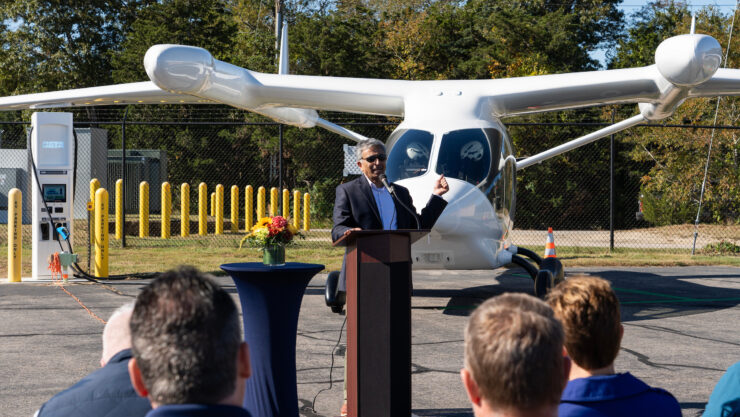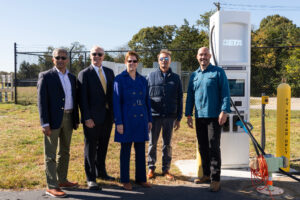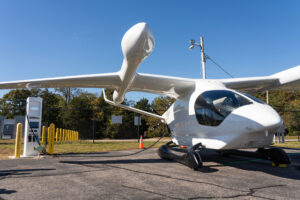Eversource, the fourth cornerstone of the electric aircraft charging foundation – Part 5

Shoreline Aviation had the drive. BETA Technologies had the expertise. MassDOT Aeronautics had the influence. And Eversource had the juice. Shake them all together, spill them out, and what do you have? The foundation of a process that resulted in the creation of Massachusetts’ first and only electric aircraft charging station.
It might have taken a few years, but it worked. As MassDOT Aeronautics Admin Jeff DeCarlo said to the audience gathered October 13 at Marshfield Municipal Airport: “You have now executed on a process that we can make more efficient.”
Or as Tilak Subrahmanian said to the same audience, “This is what we do here in Massachusetts. This is what we do.”
The audience had gathered to celebrate the commissioning of the charging station. Emissions-free electric aircraft are beginning to dot the sky, and they need a place to charge their batteries, just as jets need fuel. BETA flew its ALIA 250 electric plane in the day before, to lots of oohs and ahs, and flew it out at the event’s conclusion. BETA has two such aircraft in development stages – one Vertical Takeoff and Landing plane and one Conventional Takeoff and Landing plane. The ALIA 250 is the latter type, and its FAA certification is expected next year. Its vertical cousin is expected to be certified by 2025. The company has orders waiting to be filled.
Tilak Subrahmanian is Eversource’s Vice President of Energy Efficiency, EV Charging & Demand Response. Power management is what he’s all about.

Eversource VP of Energy Efficiency and Electric Mobility Tilak Subrahmanian, left, MassDOT Aeronautics Administrator Jeff DeCarlo, FAA Regional Administrator Colleen D’Alessandro, Shoreline Aviation President Keith Douglass, and BETA Technologies COO Blain Newton pose with BETA’s Level 3 fast charger at Marshfield Municipal Airport. Photo courtesy of BETA Technologies
“As the largest energy company in New England, we feel we have a special role here,” Subrahmanian said to the audience. “There’s a bunch of things we’re doing. Obviously working on cleaning up the supply in the first place. We have offshore wind projects we’re very, very involved in. Setting up the infrastructure. Getting that 3-phase power over here.”
The idea of installing the charging system at Marshfield Airport began as a conversation between former Shoreline employee and business development specialist Geoff Douglass and electric aviation pioneer BETA Technologies of South Burlington, Vermont. Douglass was introduced to the BETA team by leaders in NASA’s Advanced Air Mobility National Campaign. Douglass, mindful of the fragile environment surrounding Marshfield Municipal Airport and the need to decarbonize the aviation industry, became involved in the national conversation about electric aircraft.
Originally, he says, urban applications such as parking garages were seen as appropriate for eVTOL (Electric Vertical Takeoff and Landing) aircraft. He voiced the idea of employing general aviation airports for the job – that’s when the light clicked to use Marshfield as a charging base in Massachusetts. A small, busy airport in the perfect location.
But one impasse stood in the way – not enough power came down the street. Enter Eversource. The energy company installed the three-phase electric infrastructure necessary to safely and reliably power the charging stations, utilizing the Make Ready Program – the company’s EV charging rebate program.
Commonwealth Electric was contracted to assist with the installation of the system, designed by electrical engineers CMTA. Both companies featured representatives at the commissioning event.

BETA Technologies’ ALIA 250 charges at a Level 3 station powered by electricity provided by Eversource. Photo courtesy of BETA Technologies
“Innovative projects like Shoreline Aviation’s charger installation are exciting to be a part of as we look to the future of electric transportation and our role in connecting customers, businesses, communities and other stakeholders with EV chargers,” Subrahmanian said earlier. “Increasing access to electric vehicle charging is fundamental to combating climate change and achieving the commonwealth’s decarbonization goals, and we are proud of the progress we have made to support Massachusetts as a leader in electric vehicle adoption – including electric aircraft like here at the Marshfield Airport.”
The Make Ready Program was designed to aid the installation of charging stations for ground transportation vehicles. Featuring two of those in the project – Level 3 and Level 2 – let them include an airside fast Level 3 charger for aircraft.
Subrahmanian made a special callout to ComElectric and CMTA, “our partners in making this happen today. Digging up roads and trenching roads is not always welcome. Most of the time we are known for doing that, messing up the streets, or power’s out in the storm, but a huge part of our work is having to transform the community, here.”
And, it appears, helping to transform the aviation industry. One electric aircraft charge at a time.
Photos and video are courtesy of BETA Technology.
Come back for more parts to this ongoing series, featuring the insights of stakeholders and proponents of combatting global warming through technological development in aviation.
Back to News